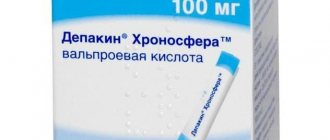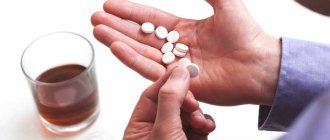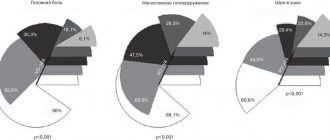Difenin tablet 117 mg x20
Trade name: Diphenin tablets 0.117 g International name: Phenytoin
Release form: tablets 117 mg (dark glass jars, cell-free contour packages, cell contour packages)
Composition: phenytoin 100 mg
Pharmacological group: antiepileptic drug
Pharmacological group according to ATK: N03AB02 (Phenytoin)
Pharmacological action: antiarrhythmic, sedative, antiepileptic,
Indications: Epilepsy, epileptic seizures, supraventricular and especially ventricular cardiac arrhythmias caused by intoxication with cardiac glycosides, prevention of ventricular arrhythmias after cardiac surgery, ventricular arrhythmias during general anesthesia, during cardiac catheterization and coronary angiography, bradyarrhythmia or heart block in case of overdose tricyclic antidepressants, rhythm disturbances associated with organic damage to the central nervous system (especially epilepsy), congenital long QT syndrome (if monotherapy with beta-blockers is ineffective), before electrical restoration of sinus rhythm in patients with atrial fibrillation after digitalization (to prevent the development of rhythm disturbances) , trigeminal neuralgia, episodic behavioral disorders (hyperexcitability, anger, anxiety, irritability, insomnia), paroxysmal choreoathetosis, myotonia (including congenital).
Dosage regimen: Orally, after meals, as an anticonvulsant and sedative drug - 0.1-0.3 g 1-3 times a day. As an antiarrhythmic drug - 0.1 g 4 times a day, the antiarrhythmic effect appears on days 3-5, after which the daily dose is reduced to 0.3 g. To quickly achieve a therapeutic concentration - 0.2 g 5 times on the first day, 0.1 g 5 once every 2-3 days and 0.1 g 2-3 times a day from the 4th day of treatment, in this case the antiarrhythmic effect is achieved by the end of 1-2 days of treatment. In children, the daily oral dose is 2-4 mg/kg. In case of severe liver failure, it is necessary to reduce the daily dose by 50%.
Contraindications: Hypersensitivity, Morgagni-Adams-Stokes syndrome, grade II-III AV block, sinoauricular block and sinus bradycardia, pregnancy, lactation.
Side effects: From the nervous system: tremor, ataxia, dysarthria, diplopia, irritability, insomnia, dizziness. From the senses: nystagmus, pain in the eyes. From the digestive system: gastritis, loss of appetite, nausea, vomiting, gastralgia. From the hematopoietic organs: leukopenia, aplastic anemia, megaloblastic, B12-deficiency anemia, agranulocytosis, lymphadenopathy. Allergic reactions: skin rash, fever, exfoliative dermatitis with hepatitis. Other: polyarthritis, hirsutism, gingival hyperplasia, weight loss, changes in connective tissue (coarsening of facial features, Dupuytren's contractures), teratogenic effects in the form of deformities of the facial part of the skull, skeletal deformities and heart defects, with long-term use (after 2-5 months) — disturbance of calcium-phosphorus metabolism, latent osteopathy.
Pharmacodynamics: An antiepileptic drug without a pronounced hypnotic effect, it has membrane stabilizing, antiarrhythmic and hypotensive effects. The antiepileptic effect is due to the stabilization of the neuronal membranes of the nerve cell body, axons and in the area of the synapse and, as a result, limiting the spread of neuronal excitation and convulsive activity. Blocks “fast” Na+ channels, reduces the entry of Na+ and Ca2+, thereby lengthening the refractory period in the process of generating nerve impulses. Antiarrhythmic properties are due to the effect on transmembrane ion exchange, while the ratio of extracellular Na+ to intracellular and, possibly, transmembrane Ca2+ exchange increases. It prevents the release of K+ from the myocardium under the influence of cardiac glycosides and, to one degree or another, neutralizes the electrophysiological changes caused by them. Without significantly affecting the automaticity of the sinus node and atrial cells in average doses, it reduces the automaticity of the cells of the His-Purkinje system, shortens the duration of the action potential in it due to the repolarization period, reduces the effective refractory period, interrupts the re-entry mechanism, reduces the severity of AV blockade caused by digitalis, does not have a noticeable effect on intraventricular conduction (the width of the QRS complex on the ECG). Increases the threshold of pain sensitivity in trigeminal neuralgia and reduces the duration of the attack.
Pharmacokinetics: Absorption - 50-80%, slow (lower in newborns). Bioavailability - 20-50%. Communication with plasma proteins is 90-95%. TCmax when taken orally varies due to different absorption rates and ranges from 1.5-3 to 15 hours. Cmax is 18 mcg/ml. Penetrates into CSF, saliva, semen, gastric and intestinal juice, bile and breast milk. Passes through the placenta (concentrations in the fetal blood serum are equal to those in the maternal blood serum). Has a “first pass” effect through the liver. Metabolized in the liver with the participation of the CYP2C9 isoenzyme. It is an inducer of the isoenzymes CYP3A4, CYP3A5 and CYP3A7. T1/2 - 24 hours. Excreted by the kidneys - 35-60%, with bile - 40-65%. Excretion increases with alkaline urine.
Special instructions: During treatment, careful selection of doses is necessary (for epilepsy, the concentration in the blood is determined on the 7-10th day of treatment), because elimination is a saturable process, and increasing doses may be accompanied by a disproportionate increase in plasma concentrations. During the treatment period, it is necessary to monitor the concentration of Ca2+ and phosphorus in the blood serum. In case of severe side effects, the dose of the drug is reduced or treatment is stopped. Carefully. Alcoholism, CHF, diabetes mellitus, fever, liver failure, cachexia, porphyria, SLE.
Interaction: Increases hepatotoxicity and prolongs the effect of paracetamol. Increases the toxicity of chlorpromazine and other derivatives of phenothiazine, reserpine, sulfonamides. Amiodarone increases phenytoin blood concentrations. Antacids containing Al3+, Mg2+ and calcium carbonate salts, drugs for parenteral nutrition, sucralfate reduce bioavailability, calcium sulfate reduces absorption by 20%. Indirect anticoagulants, chloramphenicol, cimetidine, disulfiram, antiviral vaccine, isoniazid, methylphenidate, phenylbutazone, ranitidine, salicylates, sulfonamides, fluconazole, ketoconazole, miconazole reduce metabolism, increase active concentrations in the blood and enhance the anticonvulsant effect. Anticonvulsants (succinimide, carbamazepine), estrogen-containing contraceptives, GCS and MCS, ACTH, cyclosporine, dacarbazine, digitalis glycosides, disopyramide, doxycycline, estrogens, furosemide, levodopa, mixeletine, quinidine, methadone, praziquantel, vitamin D, aminophylline, caffeine, oxtriphylline , theophylline is metabolized more intensively (due to the induction of microsomal liver enzymes by phenytoin), resulting in a decrease in their concentration in the blood. Tricyclic antidepressants, bupropion, clozapine, haloperidol, loxapine, maprotiline, molindone, MAO inhibitors, phenothiazines, pimozide, thioxanthenes, sulfinpyrazone reduce the anticonvulsant effect (therefore, dose adjustment of phenytoin may be required). Phenytoin can increase the concentration of glucose in the blood, and therefore reduces the effect of insulin and oral hypoglycemic drugs, reduces the complexation of levothyroxine with plasma proteins by 15-25%. Barbiturates, primidone, fluoxetine, folic acid can change the concentration of phenytoin in the blood (there is a need to monitor its concentration). Diazoxide reduces the hyperglycemic activity of phenytoin. Dopamine can contribute to the development of arrhythmia and lower blood pressure. Influrane, halothane, methoxyflurane - Use of phenytoin before anesthesia may increase the metabolism of the anesthetic and the risk of hepatotoxicity and nephrotoxicity. Lidocaine and beta-blockers in combination with phenytoin can depress cardiac activity, while the metabolism of lidocaine significantly increases. Omeprazole, by inhibiting the cytochrome P450 system, reduces the metabolism of phenytoin. Rifampin stimulates liver metabolism. Phenytoin protects pancreatic beta cells from the toxic effects of streptozocin. Trazodone increases blood concentrations of phenytoin. Valproic acid and phenytoin inhibit each other's metabolism, which may lead to increased hepatotoxicity. Phenobarbital and carbamazepine increase the elimination (mutually) of phenytoin. Drugs of the isoniazid group, ASA, chloramphenicol and disulfiram inhibit metabolism, increasing side effects. When co-administered with other hematotoxic drugs, increased hematotoxicity is possible.
Drug registration number: 74/331/63
Difenin
The drug increases hepatotoxicity and prolongs the effect of paracetamol; increases the toxicity of chlorpromazine and other derivatives of phenothiazine, reserpine, sulfonamides.
Amiodarone increases phenytoin blood concentrations.
Antacids containing aluminum, magnesium and calcium carbonate salts; Drugs for parenteral nutrition, sucralfate, reduce bioavailability; calcium sulfate reduces absorption by 20%.
Indirect anticoagulants, chloramphenicol, cimetidine, disulfiram, antiviral vaccine, isoniazid, methylphenidate, phenylbutazone, ranitidine, salicylates, sulfonamides, fluconazole, ketoconazole, miconazole reduce metabolism, increase active concentrations in the blood and enhance the anticonvulsant effect.
Anticonvulsants (succinimide, carbamazepine), estrogen-containing contraceptives, GCS and MCS, ACTH, cyclosporine, dacarbazine, digitalis glycosides, disopyramide, doxycycline, estrogens, furosemide, levodopa, mixeletine, quinidine, methadone, praziquantel, vitamin D, aminophylline, caffeine, oxtriphylline , theophylline is metabolized more intensively (due to the induction of microsomal liver enzymes by phenytoin), resulting in a decrease in their concentration in the blood.
Tricyclic antidepressants, bupropion, clozapine, haloperidol, loxapine, maprotiline, molindone, MAO inhibitors, phenothiazines, pimozide, thioxanthenes, sulfinpyrazone reduce the anticonvulsant effect (therefore, dose adjustment of phenytoin may be required).
The drug can increase the concentration of glucose in the blood, and therefore reduces the effect of insulin and oral hypoglycemic drugs; reduces the complexation of levothyroxine with plasma proteins by 15-25%.
Barbiturates, primidone, fluoxetine, folic acid can change the concentration of phenytoin in the blood (there is a need to monitor its concentration).
Diazoxide reduces the hyperglycemic activity of phenytoin.
Dopamine can contribute to the development of arrhythmia and lower blood pressure.
Influrane, halothane, methoxyflurane - Use of phenytoin before anesthesia may increase the metabolism of the anesthetic and the risk of hepatotoxicity and nephrotoxicity.
Lidocaine and beta-blockers in combination with phenytoin can depress cardiac activity; at the same time, the metabolism of lidocaine increases significantly.
Omeprazole, by inhibiting the cytochrome P450 system, reduces the metabolism of phenytoin.
Rifampin stimulates liver metabolism.
Trazodone increases blood concentrations of phenytoin.
Valproic acid and phenytoin inhibit each other's metabolism, which may lead to increased hepatotoxicity.
Phenobarbital and carbamazepine increase the elimination (mutually) of phenytoin.
Drugs from the isoniazid group, acetylsalicylic acid, chloramphenicol and disulfiram inhibit metabolism, increasing side effects.



